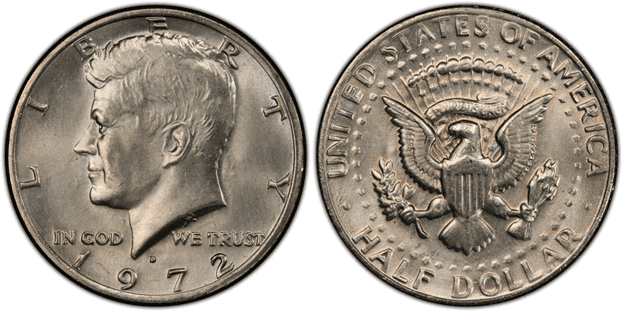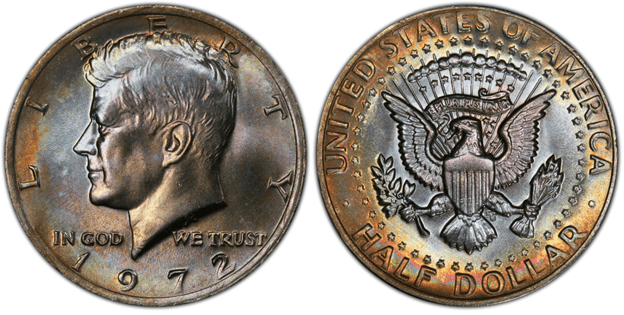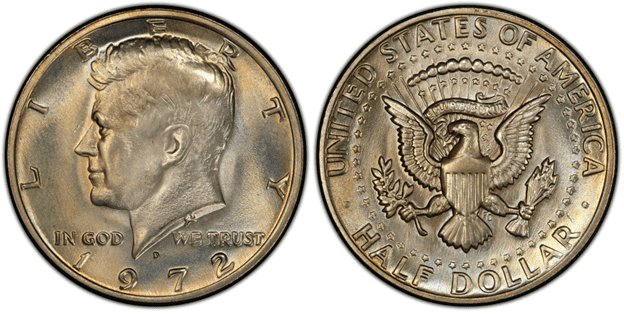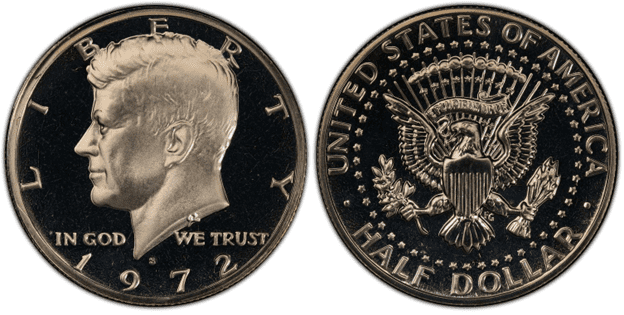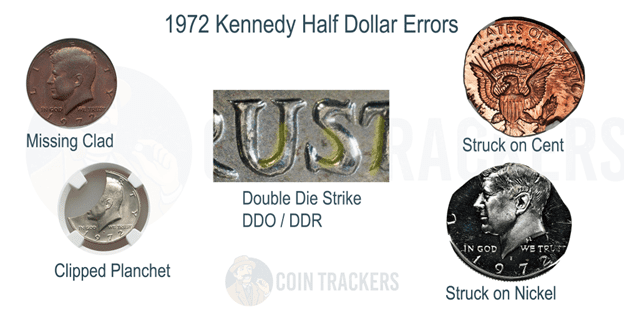What Is A 1972 Half Dollar Made Of?
The Kennedy Half Dollar, one of the most well-known and cherished coins honoring one of the most well-liked US presidents — John F. Kennedy — is conserved by both collectors and non-collectors alike.
When Congress approved the creation of a new half-dollar design to honor John F. Kennedy, the US Mint sculptors Gilroy Roberts and Frank Gasparro were selected to complete the task.
The final layout was uncomplicated and centered on honoring Kennedy and the nation he served. 1964 saw the initial production of the Kennedy half dollar, which is still in use today.
The obverse of the coin has a bust of John F. Kennedy looking to the left. Along the top of the coin are the words “LIBERTY,” and at the base of Kennedy’s neck are the words “IN GOD WE TRUST.” The mintage date is center-positioned at the bottom of the obverse.
The American bald eagle’s coat of arms is displayed on its chest, its wings spread wide. An olive branch and a group of arrows are held in the eagle’s talons. “UNITED STATES OF AMERICA” is centered at the top of the coin, while “HALF DOLLAR” is centred at the bottom.
1972 Kennedy Half Dollars are made of a copper center that comprises 75% of the coin’s metal content with a Nickel cladding comprising the latter 25%.
The coin’s edge has 150 reeds and has a diameter of 30.6mm and is 2.15 mm thick. The coin weighs 11.34 g and 153,180,000 were minted.
The USA had a somewhat active year in 1972. Mariner 9 is transmitting photographs from Mars while Pioneer 10, the first artificial satellite to leave the solar system, is launched from Cape Kennedy. The Godfather premieres in theatres in the United States. In particular, the Watergate Scandal started in 1972.
How Can You Tell If Your 1972 Half Dollar Is Silver?
While coins up until the late 60s still had some silver content, the coins minted in 1972 had no silver content and were made from a 75% copper, 25% nickel combination.
This means that if your Kennedy half dollar is dated 1972, there’s no need to check for any silver content.
What Does FG Mean On A Kennedy Half Dollar?
Frank Gasparro, who created the coin’s reverse (sometimes known as the “tail’s side”), is designated by the initials “FG” on the Kennedy half dollar.
Gilroy Roberts, incidentally, created the obverse (front or “head’s side”).
The Kennedy half dollar’s reverse was created by Gasparro, whose initials, FG, are found there. In any case, that is where you should look for them.
On a Kennedy half dollar, the FG is typically located on the bottom left quarter, directly between the eagle’s rightmost tail feather and its right leg.
A No ‘FG’ half dollar will have the signature missing from the coin, but for the coin to be viewed as a true ‘no FG’ coin it has to have absolutely no sign of the FG at all. Not even a trace under 5x magnification!
Aside from the missing letters, two other factors may be present in your coin:
- You may also see some weakness in the eagle’s feathers and other details in the vicinity of where the FG is usually found.
- Watch out for any signs of extra markings around where the FG normally is! If you see a lot of lines or scratches there, it’s possible that your coin was altered to masquerade as a no FG Kennedy half dollar.
You may be asking why Frank Gasparro’s initials, FG, were first omitted from the coin. Nobody seemed to be in pain at Gasparro’s, the renowned coin designer who oversaw the US Mint’s engraving operations from 1965 to 1981. Absolutely by accident!
Employees at the mint occasionally have to buff the damage off the coin when the dies that imprint images on blank coins get damaged. Usually, the process is successful and the clash marks or other damage indicators are immediately polished off.
However, occasionally a little bit more also comes off. The “FG” was immediately sandblasted off of the no FG Kennedy half dollars! And in that way, no FG Kennedy halves are ever produced.

photo source: www.pcgs.com
The most uncommon of these errors are thought to be the 1972-D No FG Kennedy half dollar. There could only be a few hundred. The value of a 1972-D no FG Kennedy half dollar is between $300 and $500, even in circulated condition.
A 1972-D Kennedy half dollar sold by Professional Coin Grading Service for $2,485.13 in 2016 set a record price for one without the FG initials (PCGS).
1972 Half Dollar Varieties
1972 Half Dollar With No Mint Mark
Year: 1972
Face Value: $0.50
Composition: 75% Copper, 25% Nickel
Total Weight: 11.34 g
Diameter: 30.6 mm
Thickness: 2.15 mm
Edge: 150 Reeds
Minted in: Philadelphia (Coins minted in Philadelphia have no mint mark)
Quantity Minted: 153,180,000

photo source: www.pcgs.com
1972 D Half Dollar
Year: 1972
Face Value: $0.50
Composition: 75% Copper, 25% Nickel
Total Weight: 11.34 g
Diameter: 30.6 mm
Thickness: 2.15 mm
Edge: 150 Reeds
Minted in: Denver
Quantity Minted: 141,890,000

photo source: www.pcgs.com
1972 S Half Dollar (Proof)
Year: 1972
Face Value: $0.50
Composition: 75% Copper, 25% Nickel
Total Weight: 11.34 g
Diameter: 30.6 mm
Thickness: 2.15 mm
Edge: 150 Reeds
Minted in: Denver
Quantity Minted: 3,260,996

photo source: www.pcgs.com
List of errors
Outside of the ‘No FG’ error coin, there are no other widely recoginized error coins for this year. Instead, the remaining errors are seen on a coin-by-coin basis. Listed below are some common examples seen in these coins:

photo source: cointrackers.com
- 1972 S Half Dollar Struck on Cent Planchet – This coin was produced on a planchet made for a copper penny. Since the copper planchet is smaller and red or orange in colour, a sizable amount of the coin is missing.
- 1972 D and S Half Dollars Struck on 5C Planchet – The nickel planchets used to strike these specimens. Although they appear to be the same colour, a nickel’s planchet is smaller than a half dollar’s planchet, so again, a bit of the half dollar will be missing.
- 1972 D Half Dollar Struck on 25C Planchet – These half-dollar faults appear as though the die was out of alignment and only struck a section of the planchet, but in reality, the quarter-sized planchet was struck instead, which is what created the error.
- 1972 Half Dollar Missing Clad Layer – Due to the identical composition of the coin’s centre, these coins may resemble those that have been struck on penny planchets. The planchet’s uppermost layer is known as the clad layer. The core is a copper blend, and the outer is a tin/nickel blend. The primary distinction between these two coins is that the one minted on the penny planchet will be lacking its rim and all of its writing.
How Much Is A 1972 Kennedy Half Dollar Worth Today?
Because it doesn’t have any precious metal content, Kennedy half dollars made between 1971-2014 have a melt value of only $0.1003423 which is far less than the face value.
Kennedy half dollars without silver content (outside of the No FG error) don’t hold much value, and a proof coin sells for between face value and $15, dependent on condition.
The Philadelphia and Denver mints sell for between face value and around $1.60. As mentioned, the real value of this coin comes in form of the no FG error type, which can be worth upwards of $300.
What Makes A 1972 Half Dollar Rare?
1972 half dollars were mass-produced and aren’t inherently rare, even 1972 half dollars in exception condition are worth little more than $15. The rarity of this coin comes from any errors or unique qualities seen on a coin-by-coin basis.
How Does The Grading System Work?
The Sheldon Scale is used by numismatists to provide a numerical value to coins. The Sheldon Scale goes from poor (P-1) to perfect mint state (P-1) (MS-70). Coins were originally evaluated using words to reflect their condition (Good, Fair, Excellent, Etc.). Unfortunately, coin collectors and dealers had different ideas about what each of these terms represent.
Professional numismatists joined together in the 1970s and established CoinGrading standards. These numismatists now assign grades at key places on the seventy-point scale, using the most regularly utilized numeric points in conjunction with the original adjective grade. The following are the most common coin grades:
-
-
- (P-1) Poor – Indistinguishable and probably damaged; if used, must have a date and mintmark; otherwise, rather battered.
- (FR-2) Fair – Nearly smooth, but without the damage that a coin graded Poor often possesses. The coin must have enough detail to be identified.
- (G-4) Fair – Inscriptions have merged into the rims in some areas, and important elements have been mostly erased.
- (VG-8) Very Good- A little weathered, but all of the primary design elements are visible, albeit faintly. There is little if any, central detail left.
- (F-12) Good – The item is very worn, yet the wear is even, and the overall design details stand out clearly. Rims are almost completely isolated from the field.
- (VF-20) Very Fine – Moderately weathered, with some finer features still visible. The motto or all letters of LIBERTY are readable. Both sides of the coin have entire rims that are separated from the field.
- (EF-40) Extremely Fine – Gently used; all gadgets are visible, and the most important ones are bold. The finer details are bold and clear, however, light wear may be seen.
- (AU-50) Uncirculated – Slight evidence of wear on the coin’s design’s high points; may have contact marks; eye appeal should be adequate.
- (AU-58) Uncirculated Choice – Slight traces of wear, no severe contact marks, almost full mint shine, and great eye appeal.
- (MS-60) Mint State Basal – Strictly uncirculated; no indication of wear on the coin’s highest points, but an unsightly coin with reduced luster, visible contact marks, hairlines, and other flaws.
- (MS-63) Mint State Acceptable – Uncirculated, but with contact scratches and nicks, little reduced shine, but otherwise appealing appearance. The strike is weak to average.
- (MS-65) Mint State Choice – Uncirculated with great mint shine, very little contact blemishes, and exceptional eye appeal. The strike is unusually severe.
- (MS-68) Mint State Premium Quality – Uncirculated with superb luster, no obvious contact marks to the naked eye, and exceptional eye appeal. The strike is quick and appealing.
- (MS-69) Almost Perfect Mint State – Uncirculated with perfect brilliance, a sharp and appealing strike, and extremely good eye appeal. A near-perfect coin with minor imperfections in the planchet, strike, and contact markings (seen only under 8x magnification).
- (MS-70) Mint State Perfect – Under 8x magnification, there are no tiny imperfections discernible; the strike is crisp, and the coin is perfectly centered on a beautiful planchet. Rarely seen on a coin, this coin is bright and whole, with original luster and exceptional eye appeal.
-
Where To Buy Or Sell 1972 Half Dollars?
Because they are (overall) such low-value coins, you can be pretty confident when buying and selling 1972 half dollars at online auction sites such as eBay and Etsy.
Of course, before you sell any 1972 half dollar be sure to check for the FG signature, as coins without will need to be verified and graded by a service such as PGCS before they can be sold at auction or to a specialist dealer.
FAQs
Are Kennedy half dollars still made?
Since 2002, half dollars have been produced largely for numismatic products such as annual coin sets. The Federal Reserve may nonetheless decide to put them into circulation.
Where is the mint mark on a 1972 half dollar?
The mint mark for the 1972 Kennedy Half Dollar is on the Obverse/Front of the coin just below Kennedy’s neck. If no mint mark is present it is a P and was minted in Philadelphia.
Who is on the 1972 half dollar?
Much-loved president John F. Kennedy (JFK) is featured on the 1972 half dollar.
What is the mark on Kennedy’s neck on the half dollar?
Contrary to popular belief, Kennedy’s neck stamp has nothing to do with communist plots or his assassination. Instead, it’s Gilroy Roberts’ elaborate monogram, who worked as the United States Mint’s chief engraver from 1948 to 1964.

